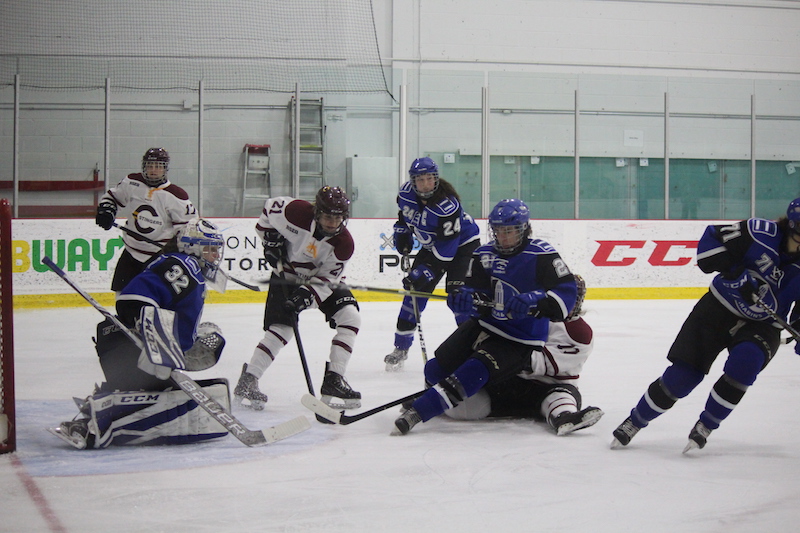3-2 loss is Concordia’s first in five games, going back to Nov. 17
The Concordia Stingers women’s hockey team lost 3-2 in a shootout against the Université de Montréal Carabins at the Ed Meagher Arena on Jan. 19. The loss snaps a five-game winning streak for the Stingers, and hands them their first defeat since Nov. 17.
This was the fourth meeting of the season between the Carabins and Stingers, the first-placed and second-placed teams in the Réseau du sport étudiant du Québec (RSEQ), respectively. Like this game, all three previous games went to overtime. The Stingers won the first two in overtime, and the third in a shootout.
“This was a playoff-calibre game,” said Stingers head coach Julie Chu. “With Montréal, we’re well-matched, and that was a lot of fun to be a part of. Despite the fact that we want to win every game, it was a good atmosphere and good intensity.”
Almost right off the opening face-off, the Stingers pressured the Carabins in the neutral zone to create a turnover. Stingers forward Stéphanie Lalancette picked up the loose puck and took a well-placed shot to beat Montréal goalie Marie-Pier Chabot just 15 seconds into the game.
“It’s always nice to start off first shot, first goal off a really good forecheck on the face-off,” Chu said.
Neither team scored for the rest off the period, as both goalies, Chabot for the Carabins and Katherine Purchase for the Stingers, made key saves.
On a power play in the opening minutes of the second period, Stingers forward Keriann Schofield made a nifty deke to beat a defender and get to the front of the net. She lost the puck right in front of Chabot, but forward Sophie Gagnon was on the doorstep to give the Stingers a 2-0 lead.
Gagnon was all over the ice, scoring the goal and drawing multiple penalties against the Carabins.
“Sophie is a worker. She’s like our warrior,” Chu said. “She’s all about grit, hard work, battling in competition, and going out there and doing what she can. She played great for us.”
The Carabins started climbing their way back into the game with a short-handed goal in the second period. While the Stingers were on the power play, some miscommunication between defenceman Caroll-Ann Gagné and forward Claudia Fortin led to a turnover to Carabins forward Jessica Cormier. She used her speed to break in against Purchase and beat her blocker-side.
“We gave up more opportunities than we created on that [power play],” Chu said. “We can’t do that.”
In the third period, both goalies were locked in and making incredible saves. Purchase made a stop with her glove while lying on her back, and just moments later, Chabot outperformed her opponent when she robbed Stingers forward Audrey Belzile with a stick save while she was lying on her side. In all, Purchase made 32 saves, and Chabot made 37.
The Carabins did get the better of Purchase with under two minutes left in the game. After sustained pressure in the Stingers zone, Carabins defenceman Valérie St-Onge threw the puck on net, and forward Audrey Lavallée tipped it in.
The Stingers outshot the Carabins 8-5 in the two five-minute overtime periods, but couldn’t beat Chabot. In the fourth round of the shootout, Laurie Mercier scored the winner for Montréal.
“You learn from your losses,” Chu said. “Games like this, you’re going to be put in tough situations […] That sets us up for a lot of learning growth for the rest of the season.”
The Carabins now have a three-point lead over the Stingers for first place, although the Stingers have two games in hand. The Stingers next play on Jan. 21 against the Carleton Ravens at the Ed Meagher Arena.
Photos by Alex Hutchins
